By Jeffrey A. Rendall, Photos by Scot Rendall
INDIO, CA – “Eagle Falls can’t be described as a genuine Links golf course, but it does exhibit certain features that you will find on a Links, particularly the sandy dunes that enhance the rough around the course,” said Clive Clark, who designed Eagle Falls Golf Course for the Cabazon Band of Mission Indians on property that the tribe owned in the bone dry California desert.
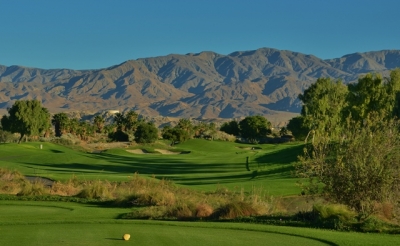 |
| Boring desert? Hardly. Beautiful mountain views are all around. Here, from the tee of the par four 2nd hole. |
Clark explained that a true Links course, by definition, must be by the ocean – and he should know, having grown up in the British Isles where he gained notoriety as a professional player. Clark now resides in nearby La Quinta, having established his own golf course design firm.
Meanwhile, the ocean is over a hundred miles away from this stretch of desert in the Palm Springs region, but that didn’t stop Clark from installing some Links-like features on the Eagle Falls course.
So how did a former European Ryder Cup Team member end up designing a course in Indio, California? Clark explains. “The Project Manager for the Cabazon Band of Mission Indians had heard good things about the course I designed at The Hideaway in La Quinta. He came over to review it with me and liked what he saw.”
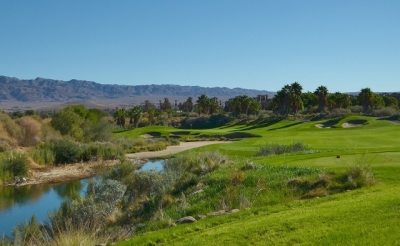 |
| Go for the green if you dare on the short par four 11th hole, but plenty of trouble awaits if you fail to hit the target. |
“The principals of the Cabazon Band of Mission Indians then came to see The Hideaway, and although only one of the group was a golfer, they also liked what they saw and immediately hired me to design their new course which is close by to their Fantasy Springs Casino & Hotel.”
True, the casino is right next door to the golf course, but the layout has its own secluded feel to it. Unlike most golf facilities in desert places, there are no condos, villas or homes bordering the fairways – so you really experience a sense of isolation at Eagle Falls.
But with isolation in a semi-dull desert environment comes challenges to build a golf course that will interest players. This area of California also has more than its share of golf offerings, so to entice people to come here, it had to be special.
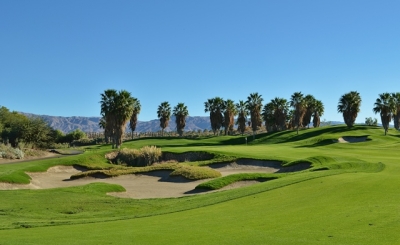 |
| The par five 7th hole is both beautiful and a difficult par. |
Clark elaborates. “Desert sites are typically flat with very little, if any, meaningful vegetation. So, once the layout of the golf course is in order, the grading plan becomes very important. Generally you have to create the golf course by moving a considerable amount of dirt. Desert courses are expensive to build because pretty much everything has to be brought into the site.”
He continues, “Features like lakes, streams and waterfalls, also come at a cost -- let alone trees and other landscape, not to mention a massive complex irrigation system so that everything can be watered and withstand the summer temperatures in the desert, which can easily rise to 120F degrees. Needless to say, when you feature lakes and streams, everything has to be lined.”
That’s not all. The Eagle Falls property also had one more sizable obstacle to overcome – the I-10 freeway. The southern end of the site has an 800-yard stretch that lies adjacent to the six-lane highway, complete with noise and built-in distractions.
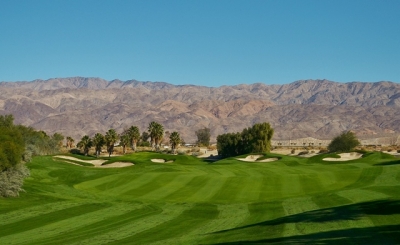 |
| Turning the corner on the par four 14th hole, there is plenty of green in front of you, and some desert, too. |
“The noise and vision of this busy freeway had to be subtly obscured,” Clark remembered. “In order to do that, we moved sufficient dirt to build mounds and dunes, which at their peaks soared up to 50-feet above the fairways. That certainly eliminated the vision of cars flying past, as well as acting as a great sound barrier.”
“It probably dropped the noise level down to a third,” Clark said.
With the freeway issue taken care of, Clark focused on adding the above mentioned touches of the old country to the Eagle Falls layout.
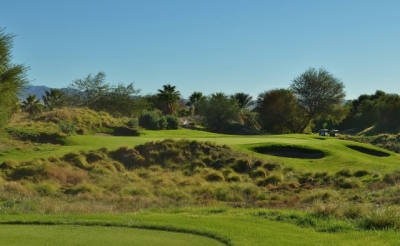 |
| The famous Postage Stamp hole at Eagle Falls is a throwback to Scotland. |
Though you won’t be completely lost in a mirage of Links golf, you’ll be a believer once you see the stacked stone walls, tall grasses and abundant mounding throughout the course.
You’ll even get to “play” a famous Links hole, though it’s not an exact replica. Eagle Falls’ par three sixth hole is a throwback to Royal Troon’s (8th hole) “Postage stamp” par three… but was made a little gentler to help resort players enjoy the experience.
Clark says the real “Postage stamp” is intriguing because it only measures 125-yards in length, yet can play exceptionally difficult. “The particular difficulty of this hole is that the green is only about 10-yards wide. If you miss left, you’re likely to get a horrible hanging lie in deep rough; or, land in the left bunker which is shaped like a letterbox.”
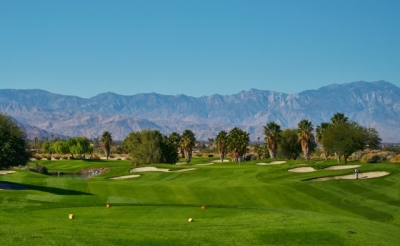 |
| The 301-yard, par four 15th hole is another that begs you to pull the driver, but a tricky green will keep you honest. |
“To play across this green and stay on, is no mean feat. Likewise, if you miss to the right, the ball will fall down a steep escarpment some 15-feet below the green and, if you’re not careful, you can stay on this hole for a long time by dint of ping-ponging the ball from side to side (which has actually happened in competition).”
Mercifully, Clark made Eagle Falls’ sixth hole 8-9 yards wider than the original in Scotland – primarily due to pace-of-play considerations.
There are other allowances that Clark made to make the course look daunting but play much easier, like offering reasonably wide fairways and approaches between bunkers guarding the greens.
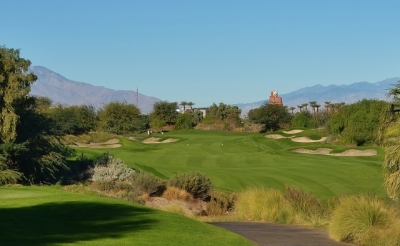 |
| But for the billboards, you would never even know you are by a busy interstate highway. Here, the par four 5th hole. |
“There is really no ‘trickery’ and yet it’s a golf course that will pose questions to the golfers and make them think. There are several risk and reward holes which have turned out exceptionally well,” Clark said.
Willie Maples, Eagle Falls’ Director of Golf, agrees that the course is challenging, yet fun.
“Clive built a challenging but not back-breaking course that sees over 85% of individuals and groups returning year after year. The native grass on the mounds which help prevent erosion on the slopes can be very difficult to play out of with much success. But the course also features four sets of tees that allow a player of any caliber to select the degree of difficulty they want.”
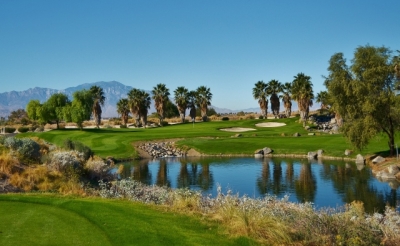 |
| There is great variety in the par threes at Eagle Falls. Here, the 16th hole. |
(Note: The back tees play to 6715 yards, so Eagle Falls isn’t brutishly long, even for mid-handicappers.)
Maples says there are several factors that allow the course to remain player-friendly, such as wide fairways, and near-perfect putting surfaces.
Maples credits course superintendent Sergio Casas and his crew of only 18 men for the superlative playing conditions. “They’re the hardest working souls you can imagine, and all of them have been with us since we opened in April of 2007.”
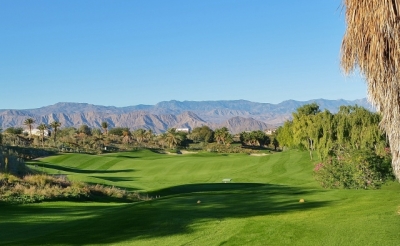 |
| The par five 4th hole is less than 500-yards in length, but you will need to fly it there to reach the green in two. |
Add in the GPS system and a cooler with ice and four bottles of water on every cart, and you’ve got all the ingredients for a pretty darn good golf experience.
And water is important on every desert course – not just the kind you hit your golf ball into, either. Summer play in the desert is not as intolerable as you might expect, but only if you have plenty of water to drink along the way. Sunscreen, too.
True to Maples’ word, we found the course in excellent condition the day we played, having reopend from the annual fall overseed just a couple weeks prior. We have also played Eagle Falls in the summer and conditions were as good as you'll find anywhere.
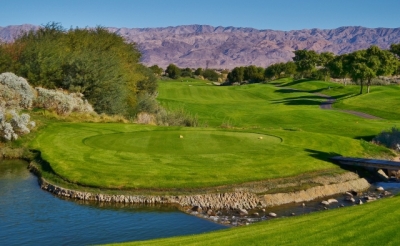 |
| From the elevated tee of the par four 10th hole, it is hard to believe the land was once basically flat. |
Earlier in the year there was a week’s worth of near 120 degree temperatures, yet Eagle Falls was still quite green and “alive” all summer. We’d call it much better than average in terms of the greenery.
Another nice feature somewhat unique to Eagle Falls (and alluded to earlier) is the utter lack of buildings on the golf course – either between holes or on the perimeter. Further, the mounding was done in such a way that even adjacent holes often seem isolated from the others. It’s a very “private” and relaxing golf experience, very impressive.
Our favorite holes included the aforementioned par three sixth, the “Postage Stamp” hole at Eagle Falls. Though only 129-yards from the back tee, Clark was right: this hole is no pushover. It’s well guarded by bunkers in all directions, and the best miss is probably short-left. A very memorable hole, indeed.
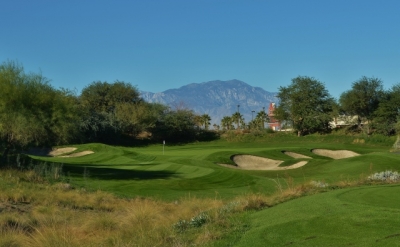 |
| Near the green on the challenging par three 9th hole. |
The par five seventh follows, a terrific three-shot par five that definitely requires a straight drive – especially from the back tees. Nearer the green, there’s a half-acre bunker and a stack-stone wall fronting the putting surface – you’ll easily see why this hole was designated the #1 handicap on the course.
On the back nine, we loved the 270-yard, par four eleventh hole. Clark describes it: “It dares golfers to go for the green! However, a lake runs all the way down the left of the hole and there is a lengthy bunker which protects the front of the green.”
“This is also reinforced by an ‘Olde English Wall’ which must be carried by golfers hopeful of getting on to the green in one shot and having a putt for an eagle. For the faint hearted, there is plenty of fairway to the right -- so to a large degree, it depends on a player’s ability and gambling instinct as to how the hole is played.”
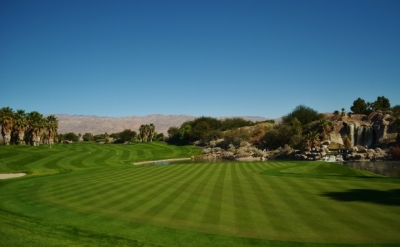 |
| Looking back from the 18th green, you see the beautiful waterfall that helps sum up Eagle Falls. |
The round concludes with the reachable par five eighteenth, playing 478-yards from the back tee. The yardage is short for a par five, but there’s a large lake protecting the front left side of the green (there is room to bail right). The course’s signature 40-foot waterfall flows down into the lake – quite a sight, and appropriately concludes the round.
Maples sums up what he’d like you to take away from Eagle Falls: “I want our players to remember they were greeted well at check-in and by outside service employees assisting them with their bags on the carts, the starter that promptly gets the golfers going at their allotted tee-time, a golf course in perfect condition, and the pleasant beverage cart staff on the course. And when ending their round, the golfers’ clubs are cleaned by outside-services and given a send-off that expresses ‘we hope to see you again soon.’”
Well put. Eagle Falls is definitely among the best in the Palm Springs area – worth a try on your next trip to the low desert.
Details:
Eagle Falls Golf Course
84-245 Indio Springs Parkway
Indio, CA 92203
Tee Times: 760-238-5633
Website: www.EagleFallsGolf.com

Director of Golf: Willie Maples, PGA
Course Designer: Clive Clark
Superintendent: Sergio Casas
Tees/Yardage/Slope/Rating
Eagle 6715 133/72.8
Hawk 6140 128/70.0
Falcon 5729 119/67.9 129/73.6 (L)
Owl 4917 119/68.8
Rates:
Consult the course website for current rates and specials.
Normally closed for over-seed the month of Oct. The FSRC offers a Golf Package that varies in rate depending on time of year. Call FSRC for details.
Note: Walking is not permitted at Eagle Falls.
| Related Links | Comments on this article? | |
|
Maryland National Golf Club Hollow Creek Golf Club Rocky Gap Resort PB Dye Golf Club in Ijamsville Whiskey Creek Golf Club |
E-mail Jeff Rendall, Editor: jrendall@golftheunitedstates.com |











